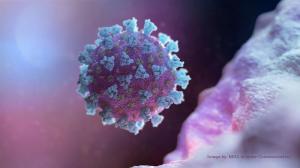Prime Minister Justin Trudeau said the trials will take place at Dalhousie University
The first Canadian clinical trials for a possible COVID-19 vaccine have been approved by Health Canada. Dr. Scott Halperin, the director of the Canadian Center for Vaccinology, explains the different phases of testing that a potential vaccine would have to go through. 8:56
A Halifax research team will be working with a Chinese manufacturer to run the first Canadian clinical trials for a possible COVID-19 vaccine.
Prime Minister Justin Trudeau made the announcement during his daily remarks on Saturday.
The trials have been approved by Health Canada and will take place at the Canadian Centre for Vaccinology (CCfV) at Dalhousie University in Halifax.
“Research and development take time, and must be done right. But this is encouraging news,” Trudeau said.
He added the National Research Council will be working with the manufacturers so that if these vaccine trials are successful, the vaccine can be produced and distributed “here at home.”
The CCfV team of about 45 people is working with a potential vaccine from Chinese company CanSino Biologics.
Health Canada said in an email Saturday that their decision followed a careful review of the trial application, which “met the necessary requirements for safety and quality.”
Researchers say about 600 participants will be needed
Scott Halperin, director of the CCfV and a professor of pediatrics, microbiology and immunology at Dalhousie University, said they are building on trials that have already begun in China.
The vaccine strain, called Ad5-nCoV, uses another virus that’s been modified so it can’t cause infection in humans, he said. It expresses one of the COVID-19 antigens on its surface called the “spike protein.”
If participants develop antibodies to fight this antigen,”one hopes that one would be protected against COVID-19,” Halperin said.
Once their team gets approval from an ethics board, Halperin hopes the trials can begin within the next two weeks.

In Phase 1, Halperin said there will be just under 100 participants of different ages involved. In the early stages, they will begin with “very healthy individuals” about 18 to 55 years old. Once their team sees some “early safety data” from those trials, he said they will bring in those 65 years of age and older.
Then in Phase 2, Halperin said they will add 500 additional participants, who might be anywhere from 18 to 85 years old.
Their team follows participants for six months after they’re immunized, Halperin said, so the whole study runs about six to eight months. However, after even a few weeks of each phase they will likely be able to learn enough to move onto the next stage.
The Phase 1 trials are “quite intensive” in terms of monitoring, Halperin said, including screening to ensure participants are healthy.
Once someone is given the vaccine, the CCfV team tests their blood, holds physical examinations, and looks at other signs and symptoms including immune response. People must also keep a diary of any symptoms.
Participants will come in a couple times in the first week, then less frequently as the weeks go on, for a total of nine to 13 times over the six months.
Director hopeful Phase 3 could come this fall
Halperin said they may be able to move to Phase 3 studies as soon as they have good data from Phase 2, which could be as early as “late summer, early fall.”
The third phase is designed to see “if the vaccine works,” Halperin said. It looks at whether participants who have received the vaccine are protected from getting COVID-19, if exposed to the virus.
Halperin said the only part of the study their Halifax team is conducting alone would be Phase 1.
When they move into Phase 2, likely in a couple months, they will be joined by multiple centres across the country through the Canadian Immunization Research Network (CIRN).
The network was originally set up around the 2009 H1N1 pandemic by the federal government, to have a national capability to “rapidly” start Phase 1 studies in extreme cases like this, Halperin said.
“It’s satisfying that the infrastructure was there in order for us to be able to respond,” he said.
An ’emergency release’ could come before study ends
He also noted that this vaccine is not the only one which will be going into clinical trials in Canada. Halperin said there will likely be others announced within the next few weeks.
Any potential vaccine won’t be publicly available until after Phase 3 is complete, Halperin said, which “could take quite a long time.”
However, Health Canada could allow the vaccine to be used before that in an “emergency release,” and there are some talks ongoing now about how that could be done.
That was the case when the Ebola vaccine was used in west Africa before Phase 3 trials were complete, Halperin said.
The CCfV team consists of nurses, data managers, research assistants, laboratory personnel, and three or four other physician investigators.







